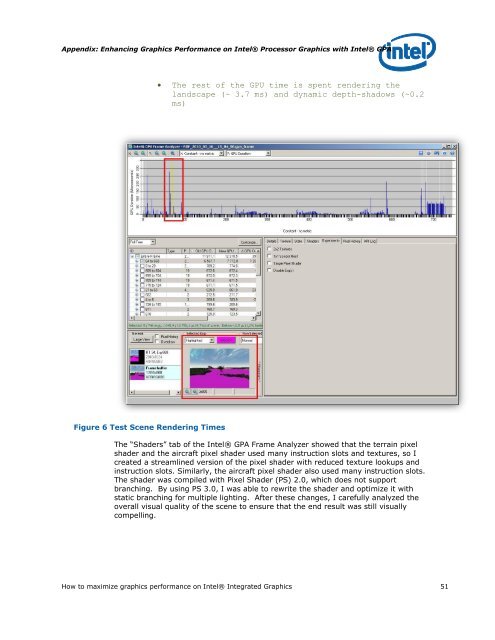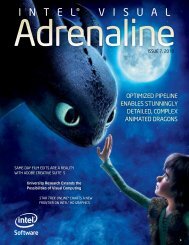Intel HD Graphics DirectX Developer's Guide (Sandy Bridge)
Intel HD Graphics DirectX Developer's Guide (Sandy Bridge)
Intel HD Graphics DirectX Developer's Guide (Sandy Bridge)
You also want an ePaper? Increase the reach of your titles
YUMPU automatically turns print PDFs into web optimized ePapers that Google loves.
Appendix: Enhancing <strong>Graphics</strong> Performance on <strong>Intel</strong>® Processor <strong>Graphics</strong> with <strong>Intel</strong>® GPA<br />
Figure 6 Test Scene Rendering Times<br />
The rest of the GPU time is spent rendering the<br />
landscape (~ 3.7 ms) and dynamic depth-shadows (~0.2<br />
ms)<br />
The “Shaders” tab of the <strong>Intel</strong>® GPA Frame Analyzer showed that the terrain pixel<br />
shader and the aircraft pixel shader used many instruction slots and textures, so I<br />
created a streamlined version of the pixel shader with reduced texture lookups and<br />
instruction slots. Similarly, the aircraft pixel shader also used many instruction slots.<br />
The shader was compiled with Pixel Shader (PS) 2.0, which does not support<br />
branching. By using PS 3.0, I was able to rewrite the shader and optimize it with<br />
static branching for multiple lighting. After these changes, I carefully analyzed the<br />
overall visual quality of the scene to ensure that the end result was still visually<br />
compelling.<br />
How to maximize graphics performance on <strong>Intel</strong>® Integrated <strong>Graphics</strong> 51













